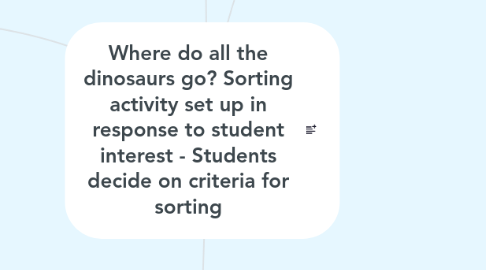
1. Children were interested in sorting by neck lengths
1.1. Reading a book about a long necked dinosaur, such as, Bertie Bracciosaurus by Ash Azalea and Lucy Beach. Story deals with friendships - Outcome 3: Children become strong in their social and emotional wellbeing. Outcome 5: Children engage with a range of texts and gain meaning from these text.
1.1.1. May lead to further learning experiences about friendships. Outcome 1: Children feel safe, secure, and supported. Children learn to interact in relation to others with care, empathy and respect.
1.2. Making long-necked dinosaurs through box construction or collage. Outcome 4: Children transfer and adapt what they have learned from one context to another. Children develop dispositions for learning such as curiosity, cooperation, confidence, creativity, commitment, enthusiasm, persistence, imagination and reflexivity. Outcome 5: Children interact verbally and non-verbally with others for a range of purposes.
1.3. Using Duplo or blocks to construct dinosaurs. Outcome 4: Children transfer and adapt what they have learned from one context to another. Outcome 4: Children transfer and adapt what they have learned from one context to another. Children develop dispositions for learning such as curiosity, cooperation, confidence, creativity, commitment, enthusiasm, persistence, imagination and reflexivity. Outcome 5: Children interact verbally and non-verbally with others for a range of purposes.
1.4. Putting up pictures of dinosaurs at 'loose parts' play area to encourage further play and experimenting with different materials to make dinosaurs. Outcome 4: Children resource their own learning through connecting with people, place, technologies and natural and processed materials.Children develop dispositions for learning such as curiosity, cooperation, confidence, creativity, commitment, enthusiasm, persistence, imagination and reflexivity. Outcome 5: Children interact verbally and non-verbally with others for a range of purposes.
2. Children interested in sorting by plant or meat-eater
2.1. If children show interest and ask questions - reading a non-fiction book for more information about dinosaur diets. Outcome 5: Children engage with a range of texts and gain meaning from these text
2.2. Children collect leaves, grass and other natural materials from outside to set up a mini dinosaur play area to allow for further play. Outcome 1: Children develop their emerging autonomy, inter-dependence, resilience and sense of agency. Outcome 2: Children become socially responsible and show respect for the environment. Outcome 5: Children interact verbally and non-verbally with others for a range of purposes
2.2.1. Encourage children to tell a 'story' using the dinosaur play. Teacher could scribe the story and assist them take pictures to make a book or video to share story. Outcome 1: Children learn to interact in relation to others with care, empathy and respect. Outcome 5: Children interact verbally and non-verbally with others for a range of purposes. Children use information and communication technologies to access information, investigate ideas and represent their thinking
3. Children interested in sorting dinosaurs by armor plates/ no armor/ head crests/ spikes
3.1. In response to further questions or interest - reading a non-fiction book to find out more about armor, head crests and spikes. Outcome 5: Children engage with a range of texts and gain meaning from these text
3.2. Displaying dinosaur images - children paint dinosaurs and glue on pasta shapes for armor or spikes etc. Outcome 4: Children transfer and adapt what they have learned from one context to another
3.3. Introduce new vocabulary (armor, spikes, crest, tail, neck, head, body, legs) and encourage students to label dinosaur. (Perhaps moving labels to the right place on an iPad, experimental writing or gluing labels on paper) Outcome 4: Children transfer and adapt what they have learned from one context to another. Outcome 5: Children express ideas and make meaning using a range of media. Children begin to understand how symbols and pattern systems work. Children use information and communication technologies to access information,investigate ideas and represent their thinking
4. Children interested in sorting by colour or size
4.1. Drawing or painting dinosaurs and talking about their colour/size. Outcome 4: Children transfer and adapt what they have learned from one context to another. Children develop dispositions for learning such as curiosity, cooperation, confidence, creativity, commitment, enthusiasm, persistence, imagination and reflexivity. Outcome 5: Children interact verbally and non-verbally with others for a range of purposes.
4.2. If children have further questions - reading a non-fiction book together to find out about dinosaur colours/sizes. Outcome 5: Children engage with a range of texts and gain meaning from these text
4.2.1. Following student interest in colour/size they may be interested in their sounds. Singing songs about the size, colour and sounds dinosaurs make. (eg. Dinosaur stomp Dinosaur Stomp | Mother Goose Club Playhouse Kids Song) Outcome 5: Children interact verbally and non-verbally with others for a range of purposes. Children use information and communication technologies to access information,investigate ideas and represent their thinking
4.2.1.1. Counting dinosaurs - 10 little dinosaurs song. (10 Little Dinosaurs | Kids Songs | Super Simple Songs Outcome 5: Children interact verbally and non-verbally with others for a range of purposes. Children use information and communication technologies to access information,investigate ideas and represent their thinking
